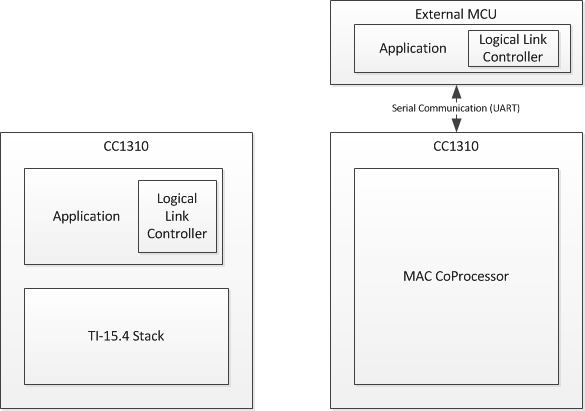Overview¶
TI’s royalty-free TI 15.4-Stack is a complete software platform for developing applications that require extremely low-power, long-range, reliable, robust and secure wireless star-topology based networking solutions. This chapter explains in detail the different network-configuration modes supported by the TI 15.4-Stack for application development. Useful information is presented for developers using the TI 15.4-Stack for their custom application development, which lets developers quickly understand the basics of the selected configuration mode and develop their end products with ease.
Architecture Choices¶
TI 15.4-Stack can be used in two separate architectures based on the end product application. Figure 19. shows the two different system architectures enabled by TI 15.4-Stack.
- A single device is shown in Figure 19. (left). The application and protocol stack are both implemented on the CC13x2 or CC26x2 as a true single-chip solution. This configuration is the simplest and most common when using the CC13x2 or CC26x2 for network nodes and also using the CC13x2 or CC26x2 as a personal area network (PAN) coordinator node. This configuration is the most cost-effective technique and provides the lowest- power performance.
- A coprocessor is shown in Figure 19. (right). The
protocol stack runs on the CC13x2 or CC26x2 while the application is executed on an
external MPU or MCU. The application interfaces with the CC13x2 or CC26x2 using the
network protocol interface (NPI) over a serial universal asynchronous
receiver/transmitter (UART) connection. The description of the API interface
is provided in the TI 15.4-Stack CoP Interface Guide document found in
the
docs/ti154stackfolder of the SDK installation directory. This configuration is useful for applications that must add long-range wireless connectivity or peripheral applications, which execute on another device (such as an external MCU) or on a PC without the requirement to implement the complexities associated with a wireless networking protocol. In these cases, the application can be developed externally on a host processor while running TI 15.4-Stack on the CC13x2 or CC26x2, which provides ease of development and quickly adds long-range wireless connectivity to existing products.

Figure 19. Single Device and Coprocessor Configuration
Data-Rate and PHY¶
The choice of PHY band and data rate can be made by setting the appropriate PHY
Id in ApiMac_attribute_phyCurrentDescriptorId PIB attribute. The overall
options are explained in Table 1.
Attention
When operating TI 15.4-Stack at 2.4 GHz (PHY ID 0) the data-rate is locked at the standard IEEE 802.15.4 data-rate of 250kbps. Channel count starts at channel 11 for this PHY.
| PHY ID | PHY Data Rate | Channel 0 Freq | # of Channels | Channel Spacing |
|---|---|---|---|---|
| 0 | 250 kbps | 2405 MHz (ch11) | 16 | 5 MHz |
| 1 | 50 kbps | 902.2 MHz | 129 | 200 KHz |
| 3 | 50 kbps | 863.125 MHz | 34 | 200 KHz |
| 128 | 50 kbps | 433.05 MHz | 7 | 200 KHz |
| 129 | 5 kbps | 902.2 MHz | 129 | 200 KHz |
| 130 | 5 kbps | 433.05 MHz | 7 | 200 KHz |
| 131 | 5 kbps | 863.125 MHz | 34 | 200 KHz |
| 132 | 200 kbps | 902.4 MHz | 64 | 400 KHz |
| 133 | 200 kbps | 863.225 MHz | 17 | 400 KHz |
Note
The 200kbps modes now support all network three network types (Beacon, Non-Beacon, and Frequency Hopping).
